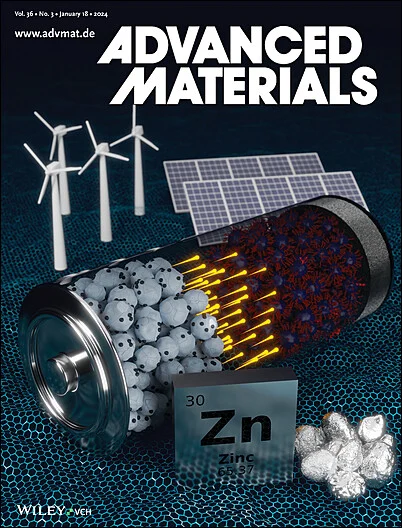Reducing Structural Distortion by Tailoring Orbital Interactions in High-Voltage Polyanionic Cathodes.
IF 26.8
1区 材料科学
Q1 CHEMISTRY, MULTIDISCIPLINARY
引用次数: 0
Abstract
The structural distortion of electrode materials in battery systems usually results in the structure degradation and capacity fading upon cycling. However, the fundamental mechanism about the structural distortion remains elusive. A critical issue has emerged concerning the utilization of high-voltage potassium vanadium fluorophosphate compound (KVPO4F) as a competitive cathode material for potassium-ion battery applications. In this work, it is initially identified that the primary distortion in KVPO4F cathode is octahedra distortion. The weak orbital interactions among central transition metal ions with ligands in an octahedron play a pivotal role in the structural distortion, resulting in an accumulation of microstrain during the cycles. This cognition serves as the foundation for the introduction of low energy-level Mn into the V sites to suppress the structure distortion and lattice microstrain. The multi-electron 3d orbitals of Mn sites tend to interact with the σ and π symmetry-matched 2p orbitals of ligands, thereby facilitating the formation of stable octahedrons to endure ion extraction steadily in high voltage. These findings provide a comprehensive understanding of structure degradation based on the octahedral distortion, thereby facilitating the enhancement of stability in high-voltage cathodes.通过调整高压聚阴离子阴极的轨道相互作用来减少结构畸变。
电池系统中电极材料的结构畸变通常会导致循环时结构退化和容量衰退。然而,结构扭曲的基本机制仍然是一个谜。关于利用高压氟磷酸钒钾化合物(KVPO4F)作为钾离子电池应用的竞争性正极材料,出现了一个关键问题。在这项工作中,初步确定了KVPO4F阴极的主要畸变是八面体畸变。中心过渡金属离子与八面体配体之间的弱轨道相互作用在结构畸变中起关键作用,导致循环过程中微应变的积累。这种认知为在V位中引入低能级Mn以抑制结构畸变和晶格微应变提供了基础。Mn位的多电子三维轨道倾向于与配体的σ和π对称匹配的2p轨道相互作用,从而有利于形成稳定的八面体,从而在高压下稳定地承受离子萃取。这些发现提供了基于八面体畸变的结构退化的全面理解,从而促进了高压阴极稳定性的增强。
本文章由计算机程序翻译,如有差异,请以英文原文为准。
求助全文
约1分钟内获得全文
求助全文
来源期刊

Advanced Materials
工程技术-材料科学:综合
CiteScore
43.00
自引率
4.10%
发文量
2182
审稿时长
2 months
期刊介绍:
Advanced Materials, one of the world's most prestigious journals and the foundation of the Advanced portfolio, is the home of choice for best-in-class materials science for more than 30 years. Following this fast-growing and interdisciplinary field, we are considering and publishing the most important discoveries on any and all materials from materials scientists, chemists, physicists, engineers as well as health and life scientists and bringing you the latest results and trends in modern materials-related research every week.
 求助内容:
求助内容: 应助结果提醒方式:
应助结果提醒方式:


